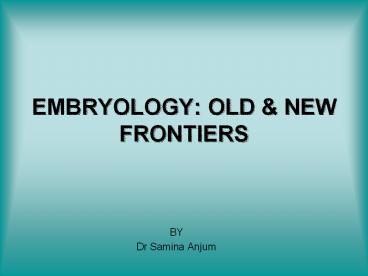EMBRYOLOGY: OLD - PowerPoint PPT Presentation
Title:
EMBRYOLOGY: OLD
Description:
EMBRYOLOGY: OLD & NEW FRONTIERS BY Dr Samina Anjum Embryology means study of embryos, however the term generally refers to prenatal development of embryos and fetuses. – PowerPoint PPT presentation
Number of Views:301
Avg rating:3.0/5.0
Title: EMBRYOLOGY: OLD
1
EMBRYOLOGY OLD NEW FRONTIERS
- BY
- Dr Samina Anjum
2
- Embryology means study of embryos, however the
term generally refers to prenatal development of
embryos and fetuses. - Developmental anatomy is the field of embryology
concerned with the changes that cells, tissues,
organs, and the body as a whole undergo from a
germ cell of each parent to the resulting adult.
3
SIGNIFICANCE OF EMBRYOLOGY
- Embryology explains the basis for understanding
gross anatomy for e.g. why left vagus supplies
the anterior surface of stomach
4
- Embryology also explains the causes of variation
in human structure and birth defects for e.g.
infectious agents, X rays or drugs.
5
(No Transcript)
6
- Embryology also provides knowledge essential for
creating health care strategies for better
reproductive outcomes.
7
BRIEF HISTORY
- Scientific approaches to study embryology have
progressed over 100 of years. This is attributed
to - Advances in optical equipment and dissection
techniques - Comparative and evolutionary studies
- Investigation of off springs with birth defects
(abnormal development) ----Teratology
8
20th CENTURY ADVANCEMENTS IN EMBRYOLOGY
- Observations of transparent embryos
- Use of vital dyes to stain living cells to follow
their fates - Radioactive labeled and autoradiographic
techniques were employed - Grafting experiments provided the first insights
into molecular signaling between tissues - Science of Teratology become prominent in1961
when a drug thalidomide caused limb defects and
for the first time the association b/w the drug
and birth defects was determined. - Molecular approaches have been added such as
reporter genes, fluorescent probes and markers
9
DEVELOPMENT
- Human development is a continuous process that
begins at fertilization, when a fertilized oocyte
(zygote), a totipotential cell is transformed
into a multicellular human being. - During this journey it has to pass through the
stages of cell division, cell migration,
programmed cell death, differentiation, growth
and cell rearrangement.
10
CELLULAR DIFFERENTIATION
- Is the process by which a less specialized cell
becomes a more specialized cell type. - Differentiation occurs numerous times during the
development of a multicellular organism as the
organism changes from a simple zygote to a
complex system of cell types and tissues.
11
APOPTOSIS
- Programmed cell death, is a normal component of
the development of multicellular organisms. - Cells die in response to a variety of stimuli
and during apoptosis they do so in a controlled,
regulated fashion.
12
CELL POTENCY
- Totipotent cell A cell that is able to
differentiate into all cell types including the
placental tissue. In mammals, only the zygote and
subsequent blastomeres are totipotent. - Pluripotent cell refers to a stem cell that has
the potential to differentiate into any fetal or
adult cell type. i.e. into any of the three germ
layers endoderm, mesoderm, or ectoderm.
13
(No Transcript)
14
- Multipotent progenitor cells have the potential
to give rise to cells from multiple, but a
limited number of lineages, for e.g. - Hematopoietic stem cell a blood stem cell
that can develop into several types of blood
cells, but cannot develop into brain cells or
other types of cells.
15
- Unipotent cell or precursor cell is one that has
the capacity to differentiate into only one cell
type, for e.g. Hepatocytes
16
HUMAN DEVELOPMENT
- Is divided into
- Prenatal period
- Postnatal period
17
PRENATAL PERIOD
- Embryonic Period
- Fetal Period
18
Embryonic Period/ Period of Organogenesis 3-8
weeks
- Process of progressing from a single cell till
the formation of organ primordia
19
Fetal Period 9th week birth
- Differentiation continues while the fetus
grows and gains weight
20
EMBRYOLOGICAL TERMINOLOGY
21
- Ovum derived from the Latin word meaning egg
- Sperm
- Derived from the Greek word sperma meaning
seed
22
- Zygote
- Cell that results from the union of oocyte and
sperm during fertilization - Embryo
- The developing human in its early stages of
development (3-8 week)
23
- Conceptus
- Embryo and its adnexa
- i.e. all structures that develop from zygote
24
- Primordium / anlage / rudiment The first
discernible indication of organ or structure
25
- Fetus (unborn offspring) The developing human
after the embryonic period (9th week - birth)
26
POSTNATAL PERIOD
- Infancy 1st year after birth
- Neonate birth -1 month
- Childhood A period from 13th month till puberty
- Puberty (period of development of sex
characteristics) - In females-12-15 years
- In males 13-16 years
- Adolescence (period of rapid physical and sexual
maturity) 11-19 years - Adult hood (Attainment of full growth and
maturity) - 18-21 years
- There after developmental changes occur very
slowly.
27
- Development does not stop at birth. Important
changes in addition to growth occurs after birth
such as development of teeth and development of
female breasts. - The brain triples in weight b/w birth and 16
years most developmental changes are completed
by the age of 25.
28
THANK YOU































